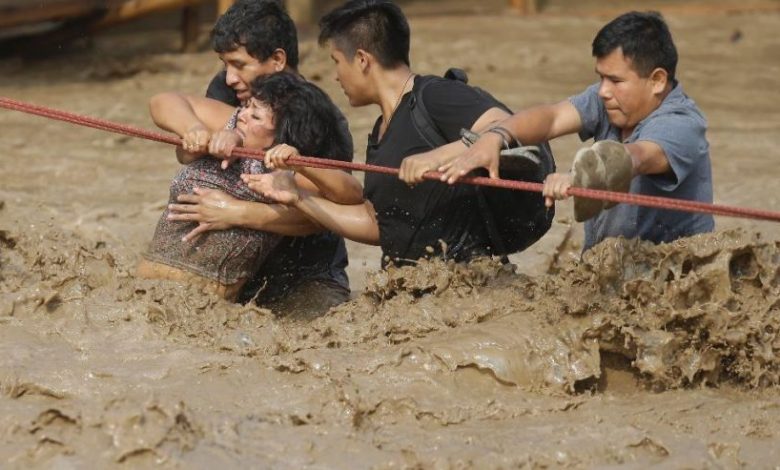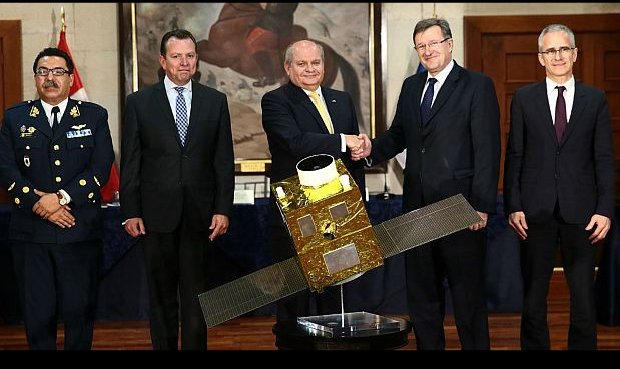A Utah Peruvian Engineer and Controversy over El Niño

Jorge Manrique Prieto a Peruvian engineer who lives in Utah, United States, has predicted a devastating EL Niño event this next year, due to underwater volcanic action in the Pacific.
In his model, the ocean is heated not only from above through solar heating, but also from below, causing the water that caresses the coast of Peru to be as much as 6 degrees warmer than during other El Niño events.
El Niños are devastating to Peruvian economy, bringing increased flooding, disruption of cycles of agriculture, and trouble with hydroelectric plants. These cycles of climate have wreaked havoc with cultures and civilizations in times past. The Chimu empire was affected by the changes of climate and the movement of Nazca plate, causing changes in elevation, and changes in their ability to irrigate their fields with canals. The movement also caused volcanic action, parts of the Pacific “Ring of Fire” which has many active volcanoes. Reference

This volcanic action is the question that is raised by Jorge Manrique Prieto. The heating of the water below – what is normally the water that is in the upwelling along the coast of Peru, which brings a wealth of sea life to the shores–could be heated by transference. The sub-marine volcanic action could heat the water deep within the ocean.

The counter argument is that there is little transference of heat from the volcanic flows to the water and that energy does not reach the surface waters. The most important input of heat comes from solar radiation, according to Sophimanía. Ellos contactó a científicos expertos del Instituto del Mar (IMARPE), Dr. Dimitri Gutiérrez Ph.D. en Oceanografía y al Dr. Ken Takahashi del Instituto Geofísico del Perú (IGP), Ph.D. en Ciencias Atmosféricas. En una entrevista, cuando se les preguntó sobre el poder de los volcanes para causar el cambio climático, dijeron, “En la era actual, el único efecto significativo de las erupciones volcánicas en el clima es de enfriamiento debido a las partículas que pueden inyectar en la estratósfera, lo cual refleja la radiación solar de vuelta al espacio y recientemente se está encontrando evidencia de que esto podría ayudar a la generación de eventos El Niño (ejemplo aquí). Pero de lejos, la fuente de energía que mantiene calientes las aguas de la “piscina cálida” es la radiación solar.” (Reference)
These researchers say that transference of heat from magna to ocean water that might cause more evaporation, which in turn leads to an El Niño event, is not possible. It comes down to a matter of math.
The amount of water that creates an ocean is vast. It is estimated that the world’s oceans contain 352 quintillion (1022) gallons of water. Thirty percent of that volume is in the Pacific Ocean. How much energy would it take to raise that amount of water by seven degrees (C), which is what Prieto is claiming?
Doing the math (an area where I claim no expertise), I found that by taking the 3.52 (1020) (the amount of water in the oceans) multiplied by .3 (30% of the water is in the Pacific), and then dividing by 24 multiplied by 4.18 petajouls (the amount of thermal energy that was estimated to be released in the Mt. St. Helens volcanic eruption, the result is 1.89(1019) petajouls, or approximately equal to 1.5 times the thermal output of the sun in one year.
This amount of thermal energy seems significant enough to raise the temperature of ocean waters.
Maya Tolstoy, a marine geophysicist at Columbia University, believes that the volcanoes should be watched more closely, and that we do not understand the mechanisms that drive them and how they relate to climate. (Reference)
In her article “Mid-ocean ridge eruptions as a climate valve” says “Changes in hydrothermal output due to plate reorganization have also been proposed to cause significant flux changes in CO2 on the tens of millions of years time scale; however, major plate reorganizations are rare.” Besides that, the events may actually help cool the globe.(Reference)
There are other mitigating circumstances, however, in the argument that sub-marine volcanic action could raise the temperature of the ocean by several degrees. A volcano that erupts under the weight of the water of an ocean does not explode with the same vengeance as one that is above the water line. The weight of the water keeps the magma ‘sealed’ within a smaller area. Another important factor is the timing of the eruptions, which are affected by tides and the stars. The earth is not solid, and there are movements in the tectonic plates, as they stretch and come together over the molten sea upon which those plates ride. Most seismic activity takes place upon the sea floor between March and April during neap tides.
Jorge has been quoted in various instances offering input on things such as the aeroport in Cusco

or a pipeline in Northern Peru (Reference)
or even on the purchase of a satellite by the Peruvian defense ministry

So is Peru going to experience “SE VIENE OTRO “NIÑO” MÁS DEVASTADOR” as predicted by Jorge Manrique Prieto? Who knows? It seems that the ‘experts’ have differing opinions and theories, and raise more questions than they answer, not the smallest of which are
Dónde está Jorge Manrique Prieto? Y Entonces, ¿quién es Jorge Manrique Prieto?
Jorge Manrique Prieto, the Peruvian engineer who lives in Utah, seems a man of many opinions and theories.




